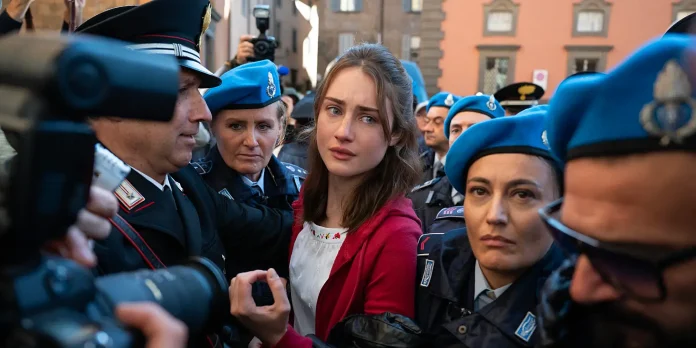THE STORY – An American college student named Amanda goes to Italy for a study abroad program, but is wrongfully imprisoned for murder; following her relentless fight for freedom and examines why she was judged so harshly by the authorities and the public.
THE CAST – Grace Van Patten, Sharon Horgan, Anna Van Patten, John Hoogenakker, Giuseppe De Domenico, Roberta Mattei & Francesco Acquaroli
THE TEAM – K.J. Steinberg (Creator), Amanda Knox & Monica Lewinsky (Executive Producers)
It’s hard to be impartial in a case as sensationalized as Amanda Knox’s. 2007 was the precipice of the 24-hour news cycle that blended the immediacy of information by way of social media, turning a murder mystery into worldwide headlines seemingly every day for years. At last, Amanda has the chance to share her story with the world through this eight-part fictionalized drama, produced by none other than Monica Lewinsky & Amanda Knox herself; if there have ever been two women more vilified, targeted, and harassed by the media, I don’t know of them. So it’s only natural that they adopt a first-person narrative in an effort to finally vindicate Knox.
Knox is painted as a naive, quirky young woman, wholly innocent of the crimes for which she was swiftly condemned, both by the court of public opinion and the unforgiving Italian justice system. As Knox’s case comes back into the cultural zeitgeist, I’ve heard musings ranging from “look what that poor girl went through” to “she was acting pretty weird, she definitely had something to do with it.” Years after the arrest and confession of the real killer, the Italian government ultimately concluded that Knox did not conspire to murder her roommate, Meredith Kercher, and fully acquitted her and her then-boyfriend, Raffaele Sollecito, in the Italian equivalent of the Supreme Court. While no longer seen as a murderer in the eyes of the law, Knox and Lewinsky are here to eliminate all doubt and convince the rest of the world of the same: that she was, in many ways, a victim herself, targeted for her unusual demeanor and viciously scapegoated for a crime she did not commit.
It’s easy to blame Knox for her mistakes – why didn’t she ask for a lawyer immediately? Why is she talking AT ALL? Why is she canoodling her boyfriend outside the crime scene where her friend and roommate is lying slain? But we have to remember she’s only 20 years old…unless you were a Law & Order addict in college, it’s hard to put yourself in her shoes.
What Knox wants to make clear is how quickly the investigation descended into injustice and corruption, fixating on her as the culprit with little more than her unconventional behavior held up as evidence. The police appeared to handle their case backwards: pick a suspect, and find evidence to build the case against her from there. Sloppy evidence collection is presented around every turn…physical evidence that doesn’t fit their narrative, like the hair of a black man on the victim’s floor? Find any black man that Knox knew, and he had to be a conspirator. Need a warrant to go into the neighbors’? Nah, just have the cops bust the window. A crime scene so bungled that it’s never closed off to the public, allowing for an open-door policy for roommates, friends, and apparently anyone who walked in off the street. Illegal wiretapping. Forced confessions through coercion. Physical abuse during the days-long interrogations. Not to mention a massive language barrier; ubiquitous American phrases like “see you later” are misconstrued as concrete plans to meet at a set time, and investigators are unwilling to hear otherwise. Every step in the arduous process to find Kercher’s killer is depicted as a witch hunt, but for most of the season, little attempt is made to explain why beyond “because she’s weird, and she’s American.”
Excluding the main prosecutor, the Italian players are construed as one-dimensional villains. Of course, we don’t know what truly went on behind the closed doors of their investigations, but this is a biased attempt at villainizing the police work, lacking subtlety and nuance. There had to be at least a little bit of depth and questioning of their determination with the real-life characters, but Steinberg makes little attempt to understand the motivations for scapegoating “the American” so quickly. But it’s Amanda’s story they’re telling, which is one of being spotted as prey and hunted from the start.
Dramatized, even a bit campy at times, the tone of the series reflects the creativity and quirkiness of the subject herself. Swinging camera work that poorly attempts to mimic Amélie (the film Knox and Sollecito were watching when the murder was taking place), the series settles in when it’s not trying to impress and takes itself and the subject more seriously. The cinematography leans heavily on yellow and red hues, evoking Italian architecture and crafting a landscape of dreamlike beauty for some, yet a nightmarish reality for those caught in the wrong place at the wrong time. A dramatized retelling of a real-life murder with a lighter tone can feel uneasy, especially when the real victim, her family, and the search for her true killer seem, at times, quietly sidelined.
The performances in a fictionalized true story can be a delicate, and almost Sisyphean undertaking, but Grace Van Patten provides much-needed depth, despair, and naivety quirkiness into an extremely impressive portrayal of Knox. Light on her feet until reality sets in (way too late) that she’s their prime suspect, Van Patten plays Knox with frustrating ease – she’s not taking the investigation seriously until she realizes she IS the investigation. Leading the emotional support cast, Sharon Horgan plays Amanda’s heartbroken mother with profound grief and weary resignation, reminding viewers of the collateral damage borne by family and friends, often overshadowed by the focus on the main character. As the self-appointed president of the Sharon Horgan fan club, it’s fun to see her stretch her acting chops (and American accent).
To this day, Meredith’s murder is always referred to in conjunction with Amanda Knox. Not the murder of Meredith Kercher, not the real killer, Rudy Guede, but Amanda Knox’s roommate. And Amanda Knox’s roommate’s killer. Knox’s name will be forever tied to a crime she did not commit, and the primary sufferer, Meredith Kercher, is likely to be overshadowed by a sensationalized and fictionalized narrative for decades to come. “The Twisted Tale of Amanda Knox” may be a biased attempt to clear a name, but it’s successful in sparking fury for more than one life ruined by a senseless act of violence in an unjust world.

THE GOOD – Well acted and well written, the series successfully introduces new outrage into this victimized young woman’s upturned life, and will likely convince even the most headstrong of skeptics of Knox’s innocence.
THE BAD – Overly dramatized and somewhat disjointed, the story offers little new information beyond what’s already known. Though it is Amanda’s narrative, it’s difficult not to feel uneasy about the way the victim’s story is pushed to the sidelines.
THE EMMY PROSPECTS – None
THE FINAL SCORE – 7/10


